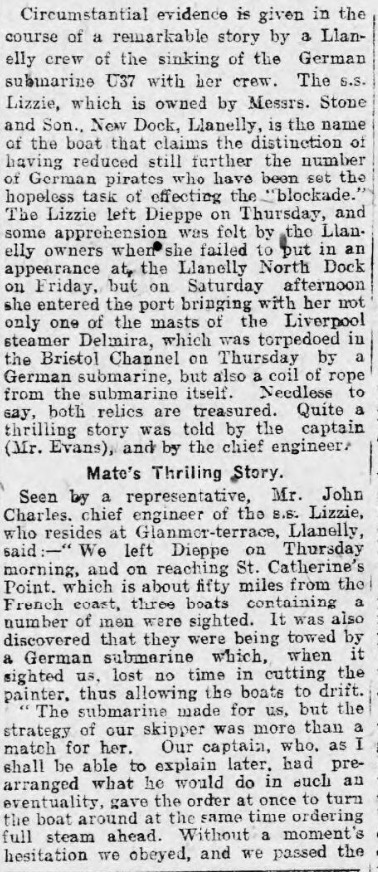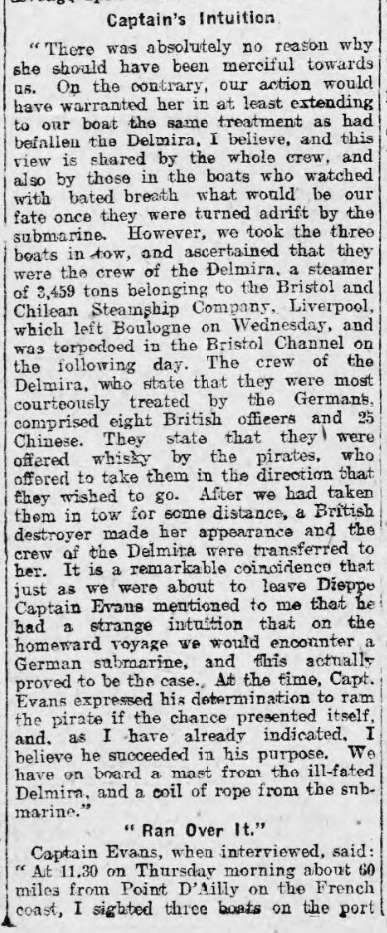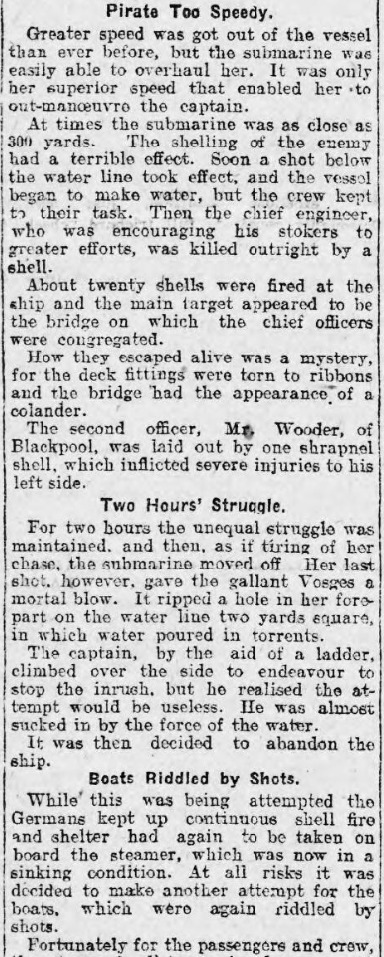Content can be downloaded for non-commercial purposes, such as for personal use or in educational resources.
For commercial purposes please contact the copyright holder directly.
Read more about the The Creative Archive Licence.
Description
Date: 29 March 1916
Transcript:
THE TABLES TURNED.
Two Submarines Reported Sunk.
PIRATES' WEEK-END WORK
British Admiralty's Statement.
The pirate submarines have been busy again during the week end, but they have had a rough time.
The captain of the Llanelly trader Lizzie, reports having, he believed, sunk a German submarine, and the Great Eastern Railway Company's steamer Brussels, also, it is stated, rammed a pirate craft.
The British Admiralty's report issued on Saturday, notifies the loss of three Brisish [sic] vessels during the week ending March 24th. During that period 1,450 vessels entered and left United Kingdom ports.
Circumstantial evidence is given in the course of a remarkable story by a Llanelly crew of the sinking of the German submarine U37 with her crew. The s.s. Lizzie, which is owned by Messrs. Stone and Son., New Dock, Llanelly, is the name of the boat that claims the distinction of having reduced still further the number of German pirates who have been set the hopeless task of effecting the "blockade." The Lizzie left Dieppe on Thursday, and some apprehension was felt by the Llanelly owners when she failed to put in an appearance at the Llanelly North Dock on Friday, but on Saturday afternoon she entered the port bringing with her not only one of the masts of the Liverpool steamer Delmira, which was torpedoed in the Bristol Channel on Thursday by a German submarine, but also a coil of rope from the submarine itself. Needless to say, both relics are treasured. Quite a thrilling story was told by the captain (Mr. Evans), and by the chief engineer.
Mate's Thriling Story.
Seen by a representative, Mr. John Charles, chief engineer of the s.s. Lizzie, who resides at Glanmor-terrace, Llanelly, said:—"We left Dieppe on Thursday morning, aud on reaching St. Catherine's Point, which is about fifty miles from the French coast, three boats containing a number of men were sighted. It was also discovered that they were being towed by a German submarine which, when it sighted us, lost no time in cutting the painter, thus allowing the boats to drift.
"The submarine made for us, but the strategy of our skipper was more than a match for her. Our captain, who, as I shall be able to explain later, had pre-arranged what he would do in such an eventuality, gave the order at once to turn the boat around at the same time ordering full steam ahead. Without a moment's hesitation we obeyed, and we passed the
CAPTAIN OF THE "LIZZlE"
[portrait of Captain Evans]
Photo by] [D. R. Evans.
Captain Evans, master of the s.s. Lizzie, now lying in the North Dock, Llanelly, which is leported to have severely damaged or sunk the U 37. He was photographed on his ship on Sunday.
submarine which by this time had become submerged. We must have rammed her, because we cruised about in the vicinity for fully half-an-hour afterwards, but no trace of the submarine could be found, except that the surface of the water where we passed over her became very oily. The German pirates must have noticed that we were deliberately attempting to destroy her, and this fact alone would lead one to conclude that she would have reeked her sevenge [sic] upon us for our audacity.
Captain's Intuition.
There was absolutely no reason why she should have been merciful towards us. On the contrary, our action would have warranted her in at least extending to our boat the same treatment as had befallen the Delmira. I believe, and this view is shared by the whole crew, and also by those in the boats who watched with bated breath what would be our fate once they were turned adrift by the submarine. However, we took the three boats in tow, and ascertained that they were the crew of the Delmira, a steamer of 3,459 tons belonging to the Bristol and Chilean Steamship Company, Liverpool, which left Boulogne on Wednesday, and was torpodoed in the Bristol Channel on the following day. The crew of the Delmira, who state that they were most courteously treated by the Germans, comprised eight British officers and 25 Chinese. They state that they were offered whisky by the pirates, who offered to take them in the direction that they wished to go. After we had taken them in tow for some distance, a British destroyer made her appearance and the crew of the Delmira were transferred to her. It is a remarkable coincidence that just as we were about to leave Dieppe Captain Evans mentioned to me that he had a strange intuition that on the homeward voyage we would encounter a German submarine, and this actually proved to be the case. At the time, Capt. Evans expressed his determination to ram the pirate if the chance presented itself, and, as I have already indicated. I believe he succeeded in his purpose. We have on board a mast from the ill-fated Delmira, and a coil of rope from the submarine."
"Ran Over It."
Captain Evans, when interviewed, said: "At 11.30 on Thursday morning about 60 miles from Point D'Aily on the French coast, I sighted three boats on the port bow being towed by a submarine, which proved to be the U 37. The submarine was some distance direct ahead of the s.s. Lizzie, and after putting on full speed ran over it. I picked up the crew of the Delmira later, and towed them in their boats until a British destroyer which came up in Sandown Bay, took them aboard. The submarine made no reappearance, and I concluded from the oily surface which appeared astern that the submarine had been vepy seriously damaged or sunk altogether."
DUEL OF SEAMANSHIP.
Submarine Bombards Steamer with Gun Fire.
The Press Association's Truro correspondent telegraphs the following graphic account of the encounter between the Moss Line steamer Vosges and the German submarine off the Cornish Coast.
When some distance off Trevose Head the submarine appeared on the starboard side of the Vosges and signalled to her to heave to[,] Captain Green ignored the request and so manoeuvred his vessel that he got the enemy astern and incapable of using his torpedoes with any effect
Then ensued a duel of seamanship. Deprived of using her torpedoesf, the submarine engineered to bring her guns into play, and in this she was successful. A blank chargo failing to cause the captain to change his mind to make a run for it[,] a live shell was discharged.
The skipper so manoeuvred his ship that it was only at intervals that the guns of the enemy could be brought to bear, but when the opportunity offered they fired with deadly effect. The captain, the first and second officers, and the boatswain were on the bridge, with the other men at their stations, and the engineers and stokers below working their hardest.
Pirate Too Speedy.
Greater speed was got out of the vessel than ever before, but the submarine was easily able to overhaul her. It was only her superior speed that enabled her to out-manoeuvre the captain.
At times the submarine was as close as 300 yards. The shelling of the enemy had a terrible effect. Soon a shot below the water line took effect, and the vessel began to make water, but the crew kept to their task. Then the chief engineer, who was encouraging his stokers to greater efforts, was killed outright by a shell.
About twenty shells were fired at the ship and the main target appeared to be the bridge on which the chief officers were congregated.
How they escaped alive was a mystery, for the deck fittings were torn to ribbons and the bridge had the appearance of a colander.
The second officer, Mr. Wooder, of Blackpool, was laid out by one shrapnel shell, which inflicted severe injuries to his left side.
Two Hours' Struggle.
For two hours the unequal struggle was maintained, and then, as if tiring of her chase, the submarine moved off[.] Her last shot, however, gave the gallant Vosges a mortal blow. It ripped a hole in her fore-part on the water line two yards square, in which water poured in torrents.
The captain, by the aid of a ladder, climbed over the side to endeavour to stop the inrush, but he realised the attempt would be useless. He was almost sucked in by the force of the water.
It was then decided to abandon the ship.
Boats Riddled by Shots.
While' this was being attempted the Germans kept up continuous shell fire and shelter had again to be taken on board the steamer, which was now in a sinking condition. At all risks it was decided to make another attempt for the boats, which were again riddled by shots.
Fortunately for the passengers and crew, the steamer's distress signals were observed by the yacht, which immediately came to the rescue. The submarine submerged on seeing the yacht approaching the steamer, and was not again seen. The crew, passengers and ship's papers were taken on board the yacht, and landed at Newquay. Here the survivors were well cared for by residents and the Shipwrecked Mariners' Society. It was found necessary to remove two to hospital.
Chief Engineer Davies was killed instantly by a shrapnel shot in the breast and went down with the ship. The lady passenger, Madame Maton, a Belgian, received a shot in the ankle. Captain Green's hand was grazed by a shrapnel shot. The submarine flew the German ensign, but no number was observed.
Surprise for Captain.
The officers and crew, in all twenty-eight, of the steamer Willerby (3,630 tons, of Stockton) a victim of the Prince Eitel Friedrich, arrived at Liverpool on Saturday in the Arabic. The Germans gave them half an hour to leave before blowing up the vessel.
The Norwegian steamer Rolf Jarl has arrived at Middlesbrough from Bergen after being held up by a German submarine, and despite the fact that she was carrying 1,900 tons or [sic] iron ore, contraband of war.
The submarine stopped her, and after an examination of her papers allowed her to proceed, to the great surprise of the Rolf Jarl's captain.
Subject of Llanelly Litigation.
One of the latest victims of a German submarine is the Surrey, which was subject of some litigation some years ago in which the Llanelly Harbour Trust was involved. It was contended for the plaintiffs that the Surrey had been damaged at Waddell's berth, Messrs. Waddell being brought in as joint defendants with the Trust. On that occaision the Trust won.
Source:
'The Tables Turned.' The Cambria Daily Leader. 29 March 1915. 6.

















Do you have information to add to this item? Please leave a comment
Comments (0)
You must be logged in to leave a comment